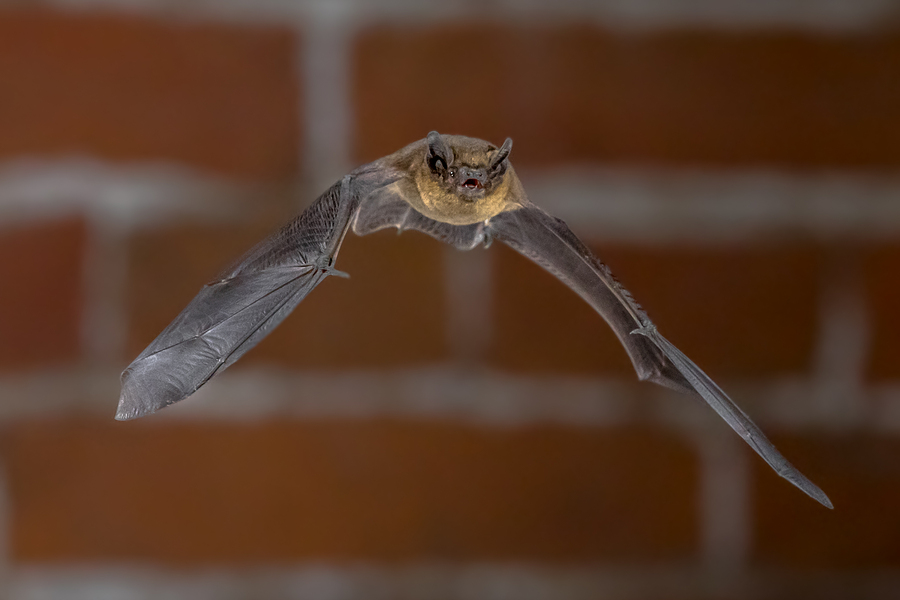This podcast talks about the types of bats in Massachusetts. Then, it explains what happens when bats enter your home, and it outlines how to deal with a bat infestation.
John Maher: Hi, I’m John Maher, and I’m here today with Ryan Potts, founder and owner of Safer Nature Pest Control, and Matt Raftery, Manager of Operations at Safer Nature Pest Control, specializing in traditional and organic pest control services in Massachusetts. Today, our topic is bat control in Massachusetts. Ryan and Matt, welcome.
Ryan Potts: Thanks, John. Thanks for having us.
Matt Raftery: Good morning. Thanks for having us.
Types of Bats in Massachusetts
John: Sure. Yeah. So, guys, what types of bats do we have here in Massachusetts?
Ryan: Primarily, what we see is we encounter the big brown bat. That’s what you’re going to find overwintering most. Sometimes you find the small brown bat as well. Massachusetts, that’s primarily what we see. If anything’s going to be nesting or overwintering in insulation, roosting in attics, that’s going to be the big brown bat.
Where Do Bats Nest in Homes?
John: Okay. And how do they get into a house and where are they typically found? You mentioned attics.
Ryan: Yeah, so big brown bat, it’s really not that big at all. The space they can get through is about a half an inch. So there’s tons of space on a roof line that we see. Typically what we’ll find is between roof junctures where one roof meets another, you’ll see soffits lining that. There’s another, drip edges, you’re going to see points of entry, a lot of those.
So you got to kind of comb the whole entire roof line to make sure that you’re keeping these guys out. We put the one-way door bat devices on those main entry points to allow them to get out naturally and not get in. But the key is really sealing up that rest of the entire roof line. Yeah, that’s how we do it.
Do Bats Cause Problems in Homes?
John: So why would you not want bats in your house, other than the obvious reasons of maybe hearing the scratching or something like that? Do they actually cause any problems in a house?
Matt: No. As far as destruction to a home, they don’t really chew on things or anything like that. The main risk is their guano droppings. It’s toxic to breathe in, so the more guano you have built up, the higher risk there is for having really serious respiratory issues, and that’s why it’s key that you have exclusion work done.
Besides that, there is a very small population of, or percentage rather, that can carry rabies. They are known rabies carriers, but they are very timid creatures. The ones that we have here in the Northeast, they’re not going to fly and attack you, but if you were to get saliva or they would break the skin, there is a rabies risk there, but the most significant health hazard is the guano that builds up.
How to Get Rid of Bats in Your Home
John: So talk a little bit more about that, about how you get rid of bats in the house. You said that there’s a one-way door so that when they leave, then they can’t come back in, so you have to get that installed on the roof line somehow?
Ryan: Yeah. Yep. Typically, we’re going to put those on where we see those main points of entry. The initial inspection, we go out and do the inspection, identify all those points of entry, and then we set up the appropriate plan of action to take care of that issue. And like I said, we’re getting up all along that roof line, setting up multiple ladders, hook ladders.
So you’re getting on top of the roof dealing with the exterior points of the roof. Again, like I said, those drip edges are very problematic depending on what size of the home, the style of the home. A lot of times you’re fine with contemporary structures, there’s going to be a lot more angles. And you also have, obviously, your gable vents. A lot of times with wildlife, sometimes even a flying squirrel could make that entry point through a screen, chew through, and that’s where the bats could be entering as well.
So all sorts of ridge vents, gable vents on the exterior of the home, and sometimes even bathroom vents we’ve seen that happen. It depends. A lot of times, again, like I say, a flying squirrel and bats, they kind of go hand in hand we find a lot, and a screen that should never have a hole in the first place, you never think it should, they typically, sometimes 90% of the time, that’s usually what it is. Again, it’s only at a half an inch where they can get through.
So we’re always inspecting that entire roof line, all vents all around the entire structure to make sure everything is sealed up properly, and then installing those one-way door devices so they can get out naturally, but not get back in.
How to Get Bats to Leave Your Home
John: How do you encourage them to leave? Do they just leave on their own when they go out to hunt or whatever?
Ryan: Yeah, so this time of year, you’re not doing major exclusion at all because bats are federally protected. Typically what we will do is do the inspection, go around the structure, identify those points of entry, and then you can only do the work at specific times of the year. And so we’re looking at May, and then you can’t touch them from basically until August 1st again. So August 1st until October, that’s when we’re doing most of our exclusion work.
Federal Protection for Bats
Matt: All of June and July it’s not allowed because that’s the pupping season and that’s our federally protected, which some of the public is aware of, some are not.
Ryan: Yeah.
Matt: But that’s why this type of work has to be exclusionary and there’s no kill.
Ryan: Yeah, you don’t kill anything.
Matt: You can’t set traps or things like that to kill bats because they’re federally protected.
John: And you said you can’t even exclude them from your house and prevent them from getting back in at certain times of the year because that’s when they’re having their babies or whatever.
Matt: Correct.
Ryan: Yeah. You don’t want to disturb them.
Matt: And the idea for that is the adults will not be able to get back to feed their young. Essentially, the risk of trapping young bats in the house is very high, so that’s why that’s a federal law.
John: Okay.
Ryan: Yeah.
John: But you could go and you could inspect a house and you could see, “Okay, they’re there, but we have to leave them alone for now and we’ll come back like you said in August or something, and then we’ll exclude them at that point.”
Why Proper Pest Identification Is Critical When Dealing With Infestations
Ryan: Right. Exactly. Sometimes we’ll get calls for bats again, and this has happened recently, there’s other companies out there that they’ll make the mistake because unfortunately they aren’t nationally wildlife trained like we are. And they’ll go in and the homeowner says, “Oh, we hear this noise, a scratching noise,” and that’s pretty common, obviously with mice. So they’ll go ahead and they’ll set up glue boards, and unfortunately they’re not doing the proper inspection.
They don’t identify the difference between bat droppings and mice droppings. And they go up there and unfortunately they’re killing bats on sticky glue traps. So we’ll get a call and the customers are like, “Well, this other company set these things up and now we have these dead bats and clearly there’s a bat issue here,” so that that’s just horrible.
John: Right.
Ryan: We get there, and it’s just awful. So they’re dead. They’re already dead.
Matt: Proper pest identification, no matter what you’re doing is key, and you have to have a proper idea on what you’re targeting before you start the job.
John: That’s interesting that you guys are sort of like what people might call exterminators, but sounds like you guys really love nature and you just don’t want it necessarily in the house. Right? But you’re taking care of nature and you don’t want to hurt those bats, and so you’re trying to do the best thing that you can for them.
Ryan: Absolutely.
Other Places That Bats Infest
John: Yep. Matt, have you ever seen bats in places in the house other than in the attic? Can they get into basements and things like that?
Matt: It’s not very common that they do that. One thing that is somewhat common is with most of the style houses we have here in the northeast with the siding, it’s almost, I don’t know if you’d call it colonial or Cape era, with shutters, which are really not functional shutters, they’re just there as decorations.
John: Right.
Matt: Sometimes those are hotspots because the edges of those vinyl shutters, there’s just a perfect half inch gap for them to get behind. And sometimes homeowners have misidentified, they think they have a mouse or something crawling around because they’re seeing droppings on the ground and I’ve pointed out that there’s bats behind the shutters.
Ryan: Yeah.
Matt: That’s something that’s really tough to permanently exclude and usually recommend removing the shutters until the bats have been excluded from other areas of the house and you’re not seeing signs of them. Ryan would be able to expand on that a bit more, but with lots of critters, there’s pheromones that a lot of pests leave behind, especially in the rodent world, and bats are not a stranger to that.
So there’s bats that will return to the same house, especially if they’ve been established there year after year to attempt to get in. I don’t know if, Ryan, you want to expand on that a little more?
How Pheromones Contribute to Repeated Infestations
Ryan: Yeah, most certainly. We see that time and time again, whether it be bats or flying squirrels or even squirrels, rodents in general, they’re going to leave a pheromone unless somebody, again is power washing a house, that’s always going to be there. They’re going to be attracted, they’re going to come back to this house, and that’s why we do full exclusion on the exterior, whether it be flying squirrels, bats, or gray squirrels. And that’s why you have to do that.
A lot of companies will go out and they’ll just install that one way door on that main entry point. And yeah, sure, you’re going to get a few of those guys out of the structure, but they’re going to be right back in there at no time. So we’re very, very thorough. We care about every single customer like it’s our family. That’s what we’re doing. We’re building relationships with our customers year after year. We do semi-annual services where we come out, and they’re lifelong customers. So we’re always trying to do our best to protect nature, protect the customer and their family first and foremost, and make sure that everything is done super thorough and right down so they don’t have any more issues.
Contact Safer Nature for Help With Bat Control
John: All right. Well that’s really great information, Ryan and Matt, thanks again for speaking with me today.
Ryan: Thank you, John.
Matt: Thanks, John.
John: And for more information, you can visit the Safer Nature website at safernature.com or call 978-325-1325.


